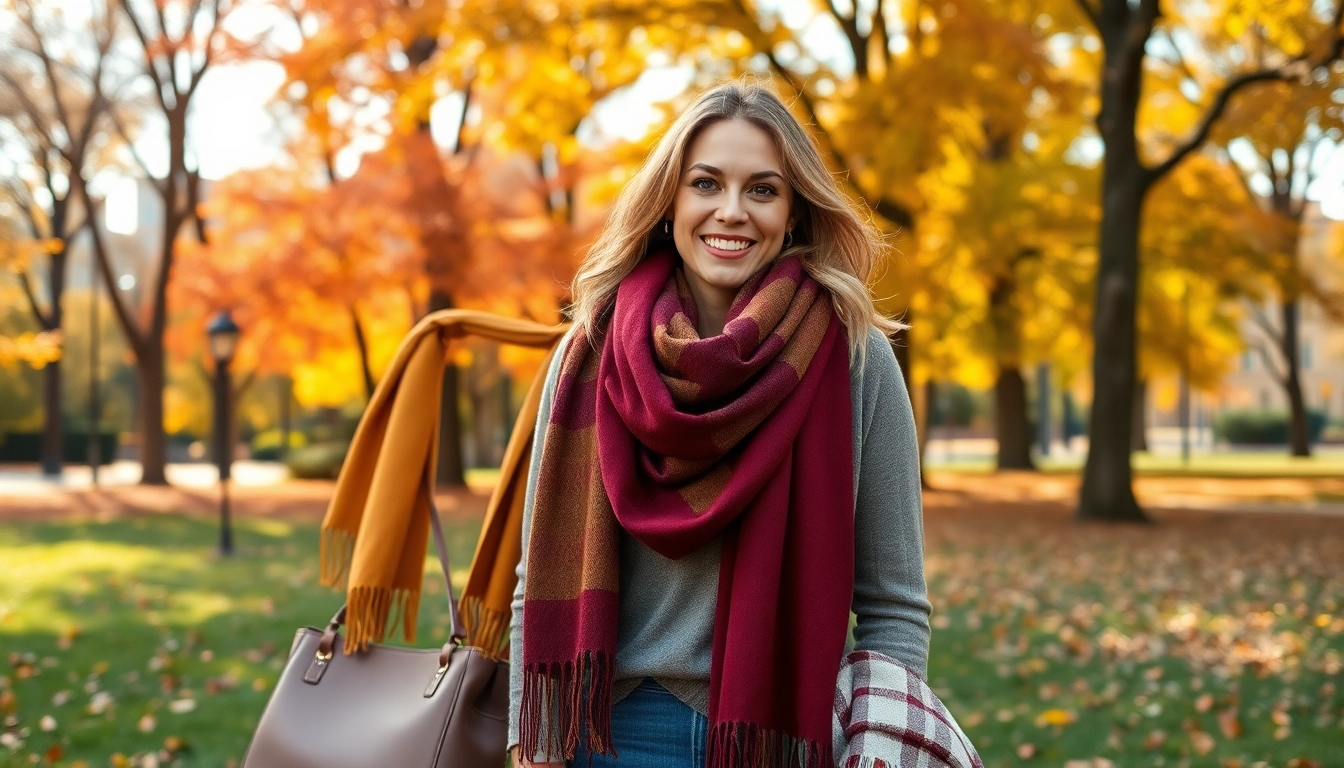Introduction to Scarves for Women
Scarves have long been a beloved accessory in women’s fashion, transcending trends and seasons. From their practical use in providing warmth to their ability to elevate an outfit, scarves for women serve multiple purposes. This comprehensive guide will explore the history of scarves, various types, styling tips, seasonal trends, material choices, and the care essentials that keep these versatile accessories looking their best. By understanding the breadth of scarf options and how to style them, women can enhance their wardrobe effortlessly.
History and Cultural Significance
The history of scarves dates back thousands of years, where they were primarily used for practical purposes. In ancient Egypt, scarves were worn by both men and women as a symbol of rank and status. Fast forward to the Middle Ages, and scarves became a fashion staple for the aristocracy in Europe, used to make a statement about wealth and refinement.
In various cultures, scarves hold significant symbolic meanings. For example, in the Middle East, women wear headscarves as a representation of modesty and tradition. In contrast, the brightly colored pashmina scarves have their origins in the Himalayas, where they not only offer warmth but also reflect intricate cultural designs and craftsmanship. This rich history adds depth and desirability to scarves, making them not just fashion items but also cultural artifacts.
Types of Scarves for Women
When considering scarves for women, the variety is astounding. Here are some popular types:
- Pashmina Scarves: Made from the hair of the Pashmina goat, these are known for their softness and warmth, making them perfect for colder climates.
- Silk Scarves: Lightweight and elegant, silk scarves can add a touch of sophistication to any outfit and are often used for both fashion and function.
- Infinity Scarves: These looped scarves are a favorite for casual wear, known for their versatility and ease of wear.
- Blanket Scarves: Oversized and cozy, blanket scarves are ideal for wrapping up in during chilly days.
- Head Scarves: Often used for styling or protective purposes, headscarves have seen a resurgence in fashion trends, as they can add flair to hairstyles or offer sun protection.
- Winter Scarves: Made from warm materials like wool or fleece, these scarves are essential for cold weather.
Why Invest in Quality Scarves?
Investing in quality scarves pays off in several significant ways. First, high-quality materials are not only more comfortable but also more durable. A well-made scarf can last for years, making it a cost-effective addition to your wardrobe. Second, quality scarves often feature intricate designs and craftsmanship that can elevate even the simplest of outfits. Lastly, premium scarves tend to retain their shape and color better compared to cheaper alternatives, ensuring that your fashion statement remains timeless.
Styling Tips for Scarves for Women
Ways to Wear Scarves: Casual to Formal
Scarves are incredibly versatile and can be styled in countless ways to suit various occasions:
- Casual Look: Throw on an infinity scarf with a fitted T-shirt and jeans for a chic and effortless vibe.
- Office Style: Opt for an elegant silk scarf tied around the neck or as a headband to add sophistication to a work outfit.
- Evening Wear: A pashmina can be draped over the shoulders of an evening gown for added warmth and style.
- Bohemian Flair: Use a patterned scarf as a headwrap or belt, adding a touch of free-spirited style to your look.
Color Combinations: Pairing Scarves with Outfits
Choosing the right color scarf can be transformative for an outfit:
- Complementary Colors: If your outfit is neutral, opt for a scarf in a vibrant color to create contrast.
- Matching Hues: Wearing a scarf that matches a color in your clothing can create a polished and put-together look.
- Patterns and Prints: Don’t shy away from mixing patterns; a floral scarf can enhance a striped shirt if done thoughtfully.
Accessories that Complement Scarves
Pairing the right accessories with scarves can enhance your overall look:
- Jewelry: Minimalist jewelry tends to work best with bold scarves, allowing the scarf to remain the focal point.
- Outerwear: A stylish coat can set the tone for how you style your scarf; a tailored coat complements scarves elegantly.
- Bags: A structured bag adds sophistication and balances the casual nature of a wrapped scarf.
Seasonal Trends in Scarves for Women
Fall and Winter Scarves: Warmth and Comfort
As temperatures drop, scarves become an essential item in your wardrobe. Winter scarves made of wool or cashmere not only provide warmth but also enhance outfits. Ideal styles for colder seasons include:
- Chunky Knit Scarves: These add texture and warmth.
- Pashmina Scarves: Perfect for their lightweight yet effective insulation.
Spring and Summer Scarves: Light and Airy Styles
In warmer months, opt for lighter scarves made from breathable materials such as cotton or linen. Styles that work well include:
- Lightweight Shawls: Perfect for layering over dresses.
- Silk Scarves: Their smooth texture and versatile use as hair accessories make them ideal.
Transitioning Scarves Across Seasons
Scarves can be worn year-round. A versatile look can be achieved with:
- Layering: Combining a summer scarf over a winter coat adds depth.
- Color Play: Opt for seasonal colors that can transition smoothly to different wardrobes.
Material Choices for Scarves for Women
Silk vs. Cotton: Understanding the Benefits
When it comes to material choices, both silk and cotton are popular. Silk scarves are celebrated for their luxurious feel and sheen but require more care. Cotton scarves, on the other hand, offer breathability, making them ideal for casual daywear. Choosing between these materials often comes down to the occasion and desired comfort level.
Wool and Cashmere: Luxury and Warmth
Wool and cashmere are the gold standards in creating warm scarves. Wool is sturdy and offers excellent insulation, while cashmere is lightweight and incredibly soft. These materials are perfect for winter scarves, providing both warmth and a high-end feel.
Environmental Considerations: Eco-Friendly Options
In recent years, the demand for eco-friendly materials has risen. Many manufacturers are now producing scarves using sustainable materials such as organic cotton or recycled polyester. These options reduce environmental impact while still delivering on style and comfort.
Caring for Your Scarves for Women
Cleaning and Maintenance Tips
Proper care can extend the life of your scarves significantly:
- Hand Washing: Many scarves, especially those made from delicate fabrics like silk, should be hand washed in cold water and mild detergent.
- Avoiding Heat: Never wring out scarves; instead, lay them flat to dry.
Storage Solutions for Scarves
How you store scarves can prevent damage and maintain their shape:
- Use Hangers: Hanging scarves on a dedicated scarf hanger can prevent creases.
- Drawer Storage: Folding scarves neatly in a drawer can work, provided they are layered with lightweight fabric in between to prevent snagging.
Repairing and Upcycling Scarves
Scarves can often be repaired or upcycled rather than discarded:
- Repairing: Small holes can usually be stitched up, and frayed edges can be trimmed or sewn to maintain the scarf’s integrity.
- Upcycling: Scarves can be transformed into hair accessories, belts, or even framed art pieces to cherish their beauty.



